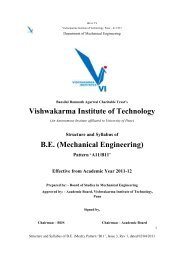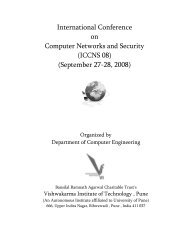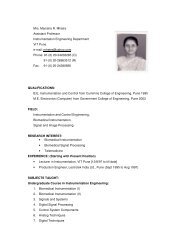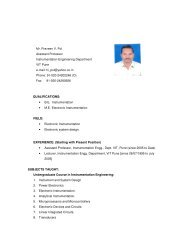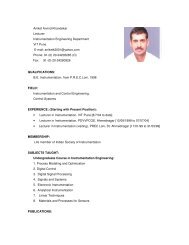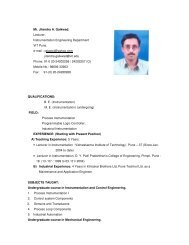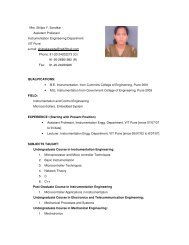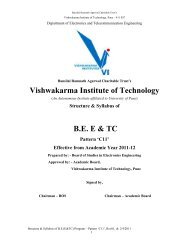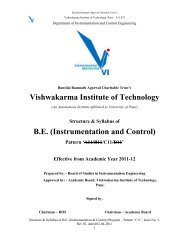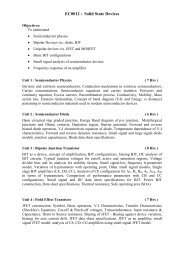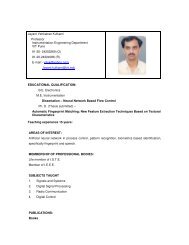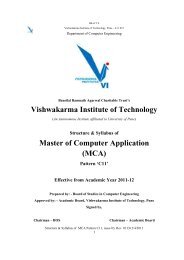Vishwakarma Institute of Technology B.E. (Electronics)
Vishwakarma Institute of Technology B.E. (Electronics)
Vishwakarma Institute of Technology B.E. (Electronics)
Create successful ePaper yourself
Turn your PDF publications into a flip-book with our unique Google optimized e-Paper software.
BRACT’S<br />
<strong>Vishwakarma</strong> <strong>Institute</strong> <strong>of</strong> <strong>Technology</strong>, Pune – 411 037<br />
Department <strong>of</strong> <strong>Electronics</strong> Engineering<br />
A. Limitations and Losses <strong>of</strong> conventional tubes at microwave frequencies.<br />
Microwave tubes – O type and M type classifications.<br />
i)O-type tubes : 2 Cavity Klystrons – Structure, Velocity Modulation Process and<br />
Applegate Diagram, Bunching Process , Expressions for o/p Power and Efficiency.<br />
HELIX TWTS: Significance, Types and Characteristics <strong>of</strong> Slow Wave Structures;<br />
Structure <strong>of</strong> TWT , Expressions for o/p Power and Efficiency.<br />
ii) M-type Tubes<br />
Introduction, Cross-field effects, Magnetrons – Different Types, 8-Cavity Cylindrical<br />
Travelling Wave Magnetron – Hull Cut-<strong>of</strong>f, Modes <strong>of</strong> Resonance and PI-Mode<br />
Operation, o/p characteristics.<br />
B.Reflex Klystrons – Structure, Applegate Diagram and Principle <strong>of</strong> working,<br />
Mathematical Theory <strong>of</strong> Bunching, Power Output, Efficiency, Oscillating Modes and o/p<br />
Characteristics.<br />
Unit IV<br />
MICROWAVE SOLID STATE DEVICES<br />
A. Principle, Construction, Characteristics and applications <strong>of</strong> Gunn Diode , Tunnel<br />
Diode, PIN diode,Varactor diode, MASER.<br />
(8 Hrs)<br />
B Principle, Construction, Characteristics and applications <strong>of</strong> PIN diode, IMPATT and<br />
TRAPATT.<br />
Unit V<br />
REAL WORLD APPLICATIONS OF MICROWAVE ENGINEERING<br />
A. Study <strong>of</strong> Microwave engineering such as in<br />
i) Radars<br />
ii) Communication<br />
iii) Industrial applications<br />
(8 Hrs)<br />
B. Microwave Power Measurement – Bolometer Method. Measurement <strong>of</strong> Attenuation,<br />
Frequency, VSWR, Cavity Q. Impedance Measurements<br />
Text Books<br />
1. Microwave Devices and Circuits – Samuel Y. Liao, PHI, 3rd Edition .<br />
2. Micro Wave and Radar Engineering – M. Kulkarni, Umesh Publications<br />
Reference Books<br />
1.Elements <strong>of</strong> Microwave Engineering – R. Chatterjee, Affiliated East-West Press Pvt.<br />
Ltd., New Delhi, 1988.<br />
2. Microwave Engineering Passive Circuits – Peter A. Rizzi, PHI, 1999.<br />
Structure & Syllabus <strong>of</strong> B.E (<strong>Electronics</strong>) Program – Pattern ‘C11’, Rev01, dt. 2/4/2011<br />
72




